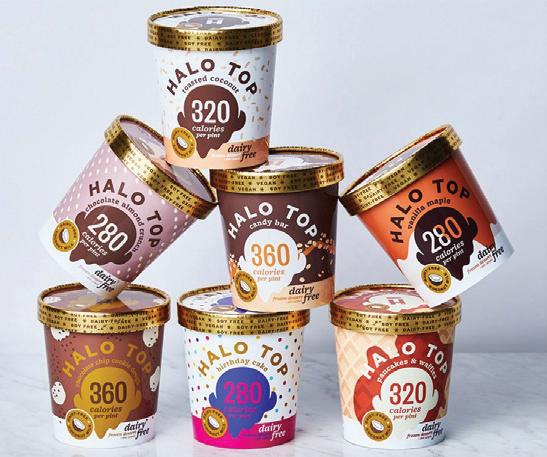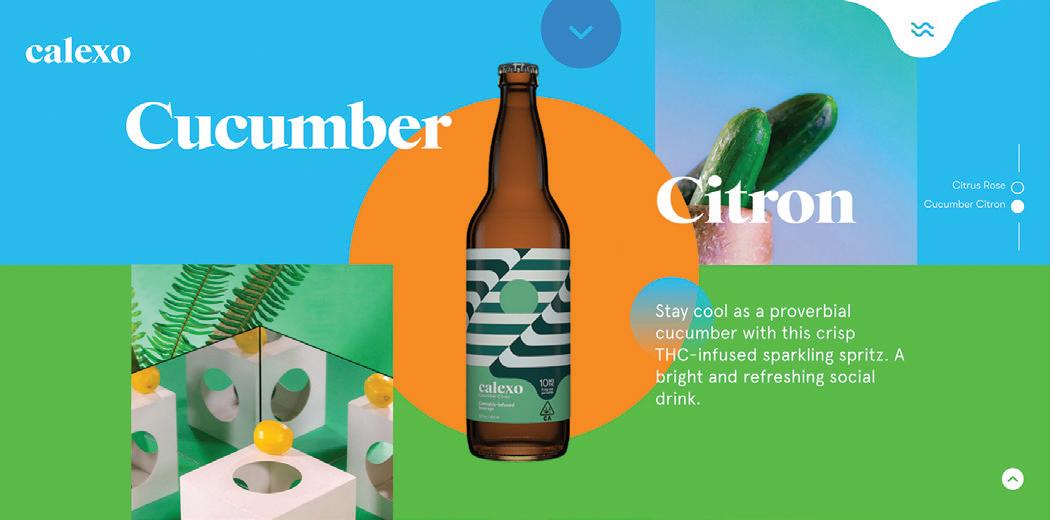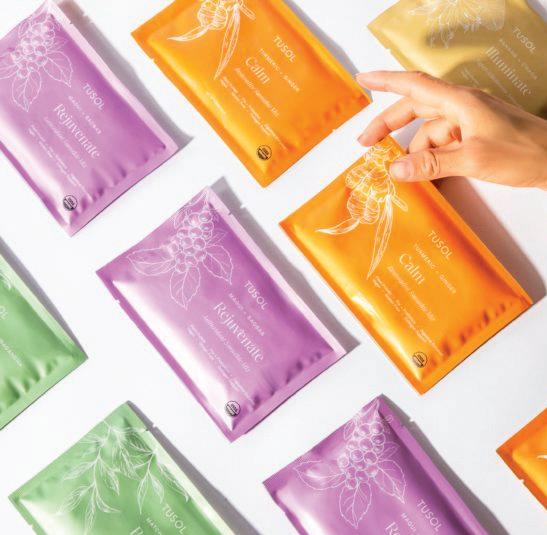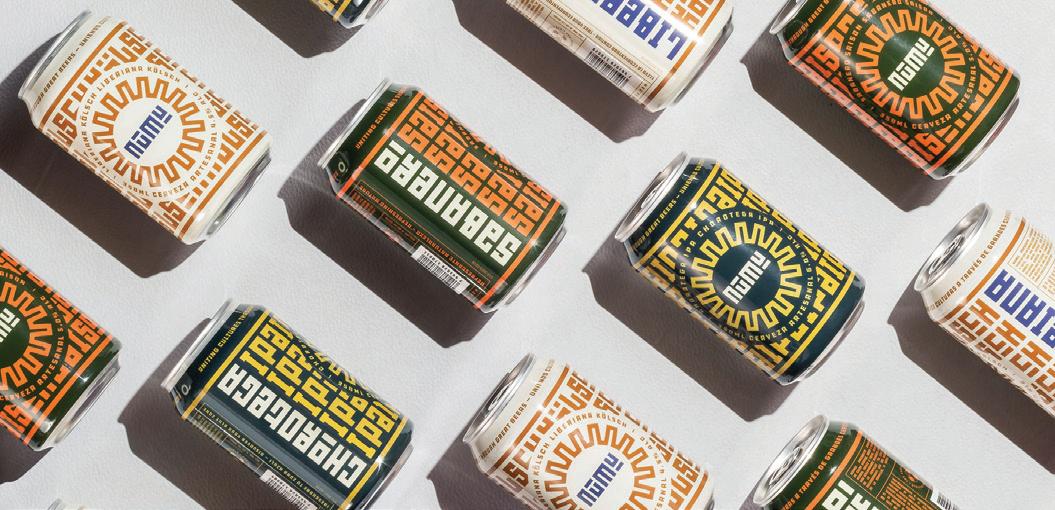
13 minute read
Packaging Design Trends
SHOWCASESHOWCASE RETRO PACK DESIGN TRENDS MIX IT UP WITH NEW E-COMM REALITIES
Brands are bringing back the vibrant colors, geometric shapes, and bold patterns that epitomized the Memphis Design trend of the ’80s, with their own modern twist. We’ll see how throwback design trends intersect with new concepts like e-commerce’s ‘unboxing’ and ‘porch appeal.’
6 Brands Reinventing the Memphis Retro Trend
By Tristan Le Breton, Contributing Editor
If you’re not familiar with Memphis Design by name, you’d likely recognize it by sight. Featuring bold, graphic patterns and retro, clashing color palettes with plenty of neon hues, the ’80s design aesthetic is hard to miss.
Design styles are often an indication of, or a reaction to, the times we’re living in; Memphis Design is the perfect example of this—both when it first came onto the scene and now.
The 1960s and 1970s were heavily influenced by modern minimalism, which played by the rule “less is more,” encouraging clean lines and neutral tones. Tired of this lack of excitement in design, a group of architects and industrial designers in Milan, Italy, responded by doing the exact opposite. Calling themselves the Memphis Group, they rebelled against the wave of understated design with a style centered around vibrant colors and a jumble of geometric shapes, stripes, and bold patterns. Initially coming to life in the form of furniture, the trend soon expanded to art, design, fashion, and popular culture.
Given that we’ve all spent much of the last 18 months stuck within the four walls of our homes, it’s no surprise we’re seeing a collective yearning for more excitement in design and beyond. Brands are once again embracing more artful trends for their packaging that not only show off their personalities, but also brighten up their customers’ days too.
Memphis Design’s loud presence may be polarizing, especially when not approached in the right way, but many brands are finding impressive ways to put their own spin on the trend and expertly walk the line between fashionably retro and dated.
Here are six brands doing a great job of bringing back Memphis Design in a modern way, one package at a time.
1. Who Gives a Crap
This Australian-founded company’s ethos is all about doing things differently, and this rings true for everything from its product to its packaging. While most of us had written off toilet paper as a boring, bland necessity, Who Gives a Crap (WGAC) saw an opportunity to innovate and stir things up, while having a positive social and environmental impact.
While WGAC’s intentions are obviously very serious, its brand personality is anything but (does toilet humor ever get old?), and it has adapted Memphis Design to epitomize this in its packaging.
Using bright colors and a mix of patterns consisting of lines, circles, and geometric shapes, it’s eye-catching, fun, inviting, and, most importantly, matches the energy of the brand. Plus, all these elements create the perfect backdrop for its logo to really stand out.
IMAGE CREDIT: WHO GIVES A CRAP

2. Temescal Brewing
From its glassware to its beer cans, Oakland, Calif.-based Temescal Brewing plays with multiple elements of Memphis design across all its brand assets. In some instances, it’s a more traditional look, using those recognizable clashing patterns and vibrant
color choices. In others, they have experimented with cool letterforms infused with Memphis vibes to let the product names and styles speak for themselves.
Temescal’s aesthetic is ultimately a perfect example of how versatile Memphis Design can be, even within one brand. Depending on the feel they want to evoke for each product, they adapt the style accordingly. The brand prides itself on being fresh and welcoming, and they cleverly use Memphis Design to send that message.
3. Doritos
While Doritos obviously has an assortment of different packaging designs, this limited-edition tangy pickle flavor is giving off serious Memphis energy. This may be the most obvious example of Memphis Design on this list, almost transporting you back to the ’80s just by looking at it.
From the flashy geometric shapes and lines to the neon colors, the design is unquestionably in your face, giving off the intensity Memphis Design is known for. While this packaging design would likely be a bit over the top for many, in this case, it’s a perfect representation of the intense flavor of the chips inside—stimulating the senses just as much as the taste!
IMAGE CREDIT: DORITOS

4. Halo Top Ice Cream
Halo Top is a game changer in the ice cream category. Much like the Memphis Group, the brand wanted to rebel against something that felt stagnant. In this case, that thing was the idea that ice cream could and should only be enjoyed in small doses.
While a bit on the more subtle side, the brand’s minimalistic use of Memphis Design aims to evoke the same pleasure and joy that comes with eating a whole pint of ice cream in one sitting. Just by looking at the variety of colors, shapes, and strokes used cleverly for each flavor, you have an idea of what the product will taste like. It feels a bit extravagant without being overly so, and this clever use of miniature shapes and lines encompass the Memphis feel without clashing with the essence of the brand.

IMAGE CREDIT: HALO TOP
5. Calexo
California-based Calexo makes sparkling cannabis beverages designed to “bring a smile to your mind.” This is perfectly embodied in its packaging, which is full of vibrant colors and graphic geometric patterns reminiscent of the fresh nature of the Memphis aesthetic. But the smiles don’t stop there, as the brand has extended the design right through its suite of brand assets, from social media to its website.
Memphis design can (intentionally) feel quite spontaneous and chaotic and can sometimes look out of place randomly applied to a packaging design. However, by embracing it across all touchpoints of its brand, Calexo maintains brand consistency and recognizability—which are vital attributes for building trust and long-lasting connections with customers.

IMAGE CREDIT: CALEXO
6. Mighty Gum

Mighty Gum’s packaging shakes things up with a softer take on classic Memphis Design. Instead of straight lines, rigid geometric patterns, and bright colors, the brand mixes things up by incorporating more organic shapes, and muted and restrained colors, all overlaid with tiny zigzag illustrations.
This is a great example of reworking a trend to best suit your brand ethos and better appeal to your target audience. The way in which Mighty Gum has applied Memphis Design helps the brand differentiate itself from other gums on the market, without distancing itself from its ideal customers. And following the crowd was never what Memphis was about anyway!
There’s a common theme that all these brands share, and that’s the desire to be known for doing things a little differently. If you’re also looking to help your products stand out from the crowd, then Memphis may be the design style for you. But, as is the case with any packaging design, whatever you choose should be reflective of your personality, values, and goals as a brand. Feel free to make Memphis entirely your own—after all, the style itself was born out of breaking the rules! PW
Tristan Le Breton is Creative Director of 99designs, the global creative platform by Vistaprint.
s 5 Emerging Trends in E-commerce Package Design
By Shayne Tilley, Contributing Editor
While e-commerce was already well established before the pandemic, 2020 certainly prompted widescale changes in online shopping behavior that appear permanent. As retailers fought to continue operating after closing their physical stores, we also saw unprecedented e-commerce adoption as both business owners and consumers worked to keep up with this new retail reality.
This was brave new territory for many small businesses that, among many other things, now had to consider how they could continue making meaningful connections with their customers in a socially distanced world. Suddenly, the box in the mail became the only chance for brands to have a physical interaction with buyers— and this has had an interesting effect on packaging design!
When looking at the design trends shaping e-commerce packaging this year, there is a clear theme. Thanks to the astronomical rise of online shopping, we’ve seen an increasing number of brands turning away from plain or stock packaging. Instead, boxes are now looking like works of art in their own right as brands aim to deliver a little piece of their personality straight to customers’ doorsteps.
Let’s take a look at five of these artful trends shaping packaging right now.
1. Solid, all-over color
Probably one of the most simple but effective trends in e-commerce packaging design right now, this style sees products packaged in single, solid colors. Unlike other trends, which make use of intricate illustrations or bold typefaces, it’s the use of bold, bright, and often unconventional shade choices that draw the buyer in. The correct color choices can both create a specific aesthetic for your products as well as give customers subtle clues about the ingredients.
For example, Los Angeles-based superfood smoothie maker TUSOL Wellness uses a range of shades directly representing the hero ingredient of each of its individual smoothie sachets, making each flavor easily recognizable. The color choices are also paired with a shiny, metallic material, giving each sachet a luxurious look and feel.
While this trend is a lot more understated, it is an incredibly powerful way to ensure products stand out against the competition.

2. Hyper-simplistic geometry
Another design trend shaping (literally) the packaging world right now is the use of simple yet striking geometric concepts. Here, designs incorporate straight and neat lines and tight angles paired with distinctive colors to make an unforgettable impression on customers.
While geometric patterns may look plain at first glance, the superpower of this design style is in its abstract simplicity. Instead of straight up showing or telling customers with illustrations or imagery, these clever geometric elements give them hints of what to expect when they open things up. For example, the grid-like design on California’s Sincere Cider uses various elements and colors inspired by apples to evoke the crisp, clean flavors to be found within.

3. Product names front and center
It’s time to let your product names do the talking with the use of striking typography that makes each word feel like a piece of artwork in itself. Rather than placing a logo, brand name, or illustration center stage, the names of the products themselves are now the star of the show. Any additional design elements are simply used to make the name stand out.
As this style leaves no doubt as to what the product is called or does, it is the perfect trend for product-focused businesses that are looking to increase brand awareness. Through the use of creative and eye-catching lettering, this design style has the unique ability to give a product a distinctive personality all its own.
Unlike most traditional supplement companies, Minnesota’s Crystal Star has leveraged this trend on its simple yet stylish packaging to appeal to customers seeking alternative wellness products. Pairing strong typefaces with clean, bright colors for the product names on its bottle labels, these products can entice older and younger generations alike.

4. Organically shaped color blocking
Undoubtedly one of the most popular design trends right now, this style beautifully merges the shift towards increasingly environmentally conscious consumer sentiment and the overarching art-inspired design trend seen right now in e-commerce.
Color blocking as a concept isn’t exactly new. But doing so with softer and more natural colors, shapes, and textures? That’s very 2021. Rather than clear, straight, lined boxes of color, these are collages of unbalanced, unevenly weighted shapes overlaid with freckles, squiggles, and spirals.
Whether abstract or portraying scenes found in nature, these designs are a welcome breath of fresh air for so many of us who spent the majority of the past 12 months cooped up inside. A great example can be found with clean skincare brand ORPHEUS, which uses soft organic shapes and colors on its packaging to create the image of a stunning ethereal landscape that is a nod to the Resurrection Flower found in its products.

5. Picture-perfect symmetry
It’s not uncommon for the top design trends each year to appear contradictory. In fact, it’s almost expected! Not everyone likes the same pizza toppings, so to speak. While some designers and brands are experimenting with imperfect shapes and unusual patterns, we’re also seeing packaging that swings in the complete opposite direction by playing with order and balance.
Whether incredibly complex and tight illustrations or looser, more disconnected patterns that leverage negative space, the visually satisfying nature of symmetry elicits a sense of calm, order, and grounding—starkly contrasting the chaos of the last year. A perfect example can be seen on the bold and almost hypnotic symmetrical patterns on the beer cans of Costa Rica’s Numu Brewing.

Now it’s time to get started!
Whether you’re an e-commerce business looking to level up your packaging game this year or a fresh, new brand just starting out, tapping into design trends can be an easy yet effective way to ensure your brand stands out and leaves a lasting impression on customers. But when the design trends all look so incredible, deciding which style is right for your brand can be a bit daunting. In this instance, it can be helpful to ask yourself a series of questions before you start the product packaging design process. • What is the product? Of course, you need to know how big it is, what shape it is, and what it does to inform the logistical side of things. But by breaking it down even further, you can draw out inspiration for the type of design you’re going to use. What ingredients is it made of? Does it have a particular scent or texture? As we saw with the above trends, often the design—whether it’s a pattern, illustration, or clever use of colors—is so much more than simply an embellishment. • Who’s buying the product? Your packaging should appeal to your ideal customer, so it’s important that you know who that customer is before designing your packaging. So next you need to ask yourself, who’s your target audience? What do they value and need? Are they old or young? Are they environmentally conscious? Are they on a budget, or do they have a higher disposable income? By homing in on your ideal customer and what’s important to them, you can narrow down your design choices to something that’s truly going to catch their eye. • Who are you as a brand? Finally, ensure you know who you are as a brand. It’s all very well creating stunning packaging, but if it doesn’t mirror your values, purpose, and personality, it’s not going to create a seamless brand experience. This doesn’t mean you can’t experiment with quirky design, but it should fit within the parameters of your overarching brand narrative. Are you playful or serious? Are you luxurious or cost-effective? Energetic or stoic? And most importantly, what do you stand for?
The answers to the above questions will help you form a blueprint that will guide every facet of your packaging design—from fronts, logos, copy, and colors right through to the materials and different layers you use.
With many consumers realizing that shopping online is beneficial for their daily lives, there’s no doubt that e-commerce looks set to be the norm for many of us. And with the effects this has already had on e-commerce packaging design, it’s likely we can expect to see plenty of beautifully designed packages arriving in our homes for the foreseeable future. PW
Shayne Tilley is Head of Marketing for 99designs, the global creative platform by Vistaprint.



